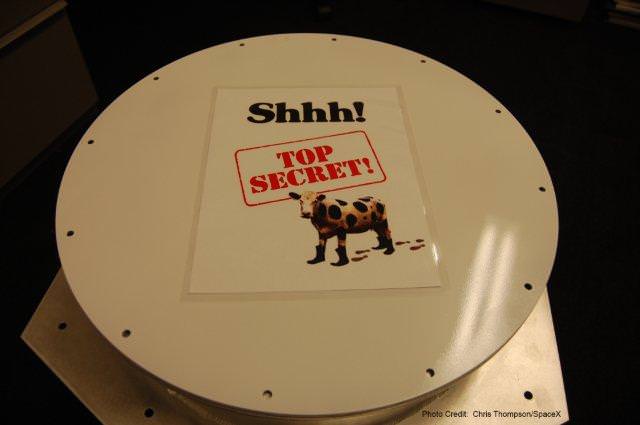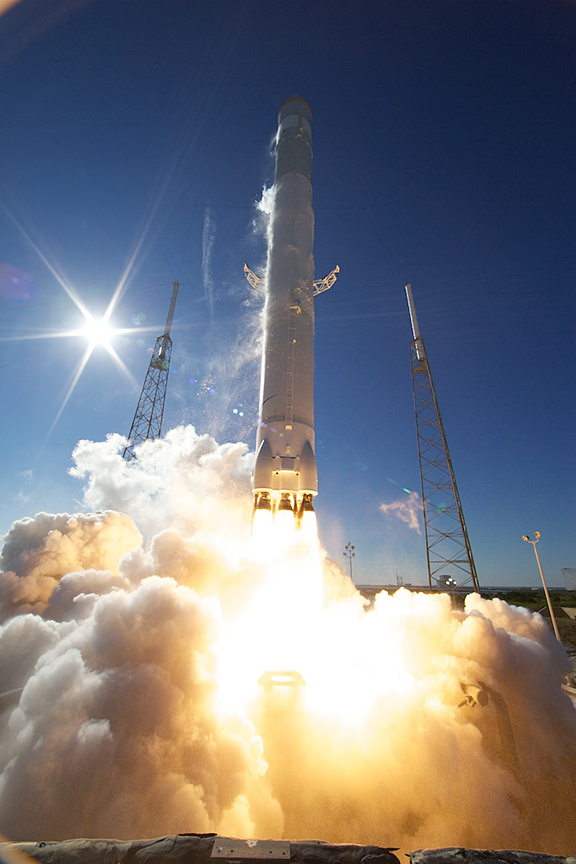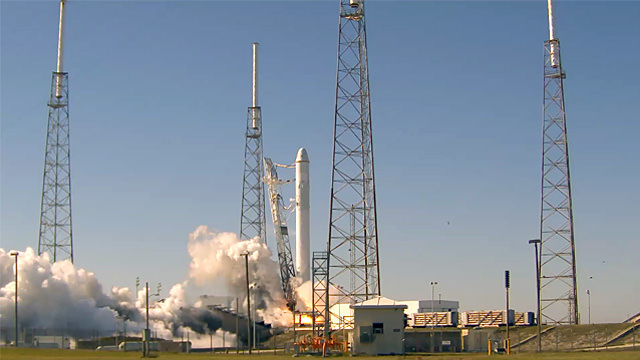OK, SpaceX, you’ve got us intrigued. This video released today by SpaceX says something “big” is coming on April 5, 2011. No embargoes, either!
More Images, Details on SpaceX’s Dragon Flight
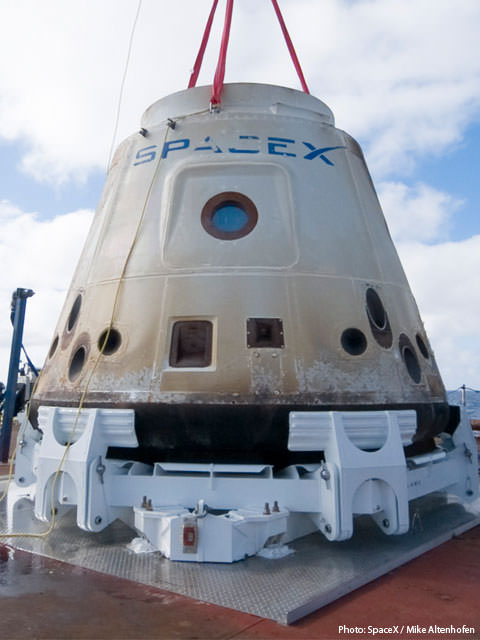
[/caption]
SpaceX has released more images and more details about the successful flight of Falcon 9 and the Dragon capsule that took place on December 8, making SpaceX the first commercial company in history to re-enter a spacecraft from Earth orbit. Here’s an image of Dragon safely on board a ship after splashdown. SpaceX said Dragon orbited the Earth at speeds greater than 7,600 meters per second (17,000 miles per hour), reentered the Earth’s atmosphere, and landed less than one mile from the center of the targeted landing zone in the Pacific Ocean. Wow, that’s some pretty good precision. See more images and details of the flight below.
The above image also shows a look at Dragon’s PICA-X heat shield, which SpaceX says is highly advanced. They worked closely with NASA to develop the heat shield, a variant of NASA’s Phenolic Impregnated Carbon Ablator (PICA) heat shield, which NASA used for the Stardust sample capsule returned, which set the record for the fastest reentry speed of a spacecraft into Earth’s atmosphere — experiencing speeds of 46,510 kph (28,900 mph).
NASA made its expertise and specialized facilities available to SpaceX as the company designed, developed and qualified the 3.6 meter PICA-X shield in less than 4 years at a fraction of the cost NASA had budgeted for the effort. The result is the most advanced heat shield ever to fly. SpaceX said one heat shield can potentially be used hundreds of times for Earth orbit reentry with only minor degradation each time, and that this flight proved it. During the press conference following the successful flight of Dragon, SpaceX CEO Elon Musk said this heat shield could even withstand the much higher heat of a moon or Mars velocity reentry.
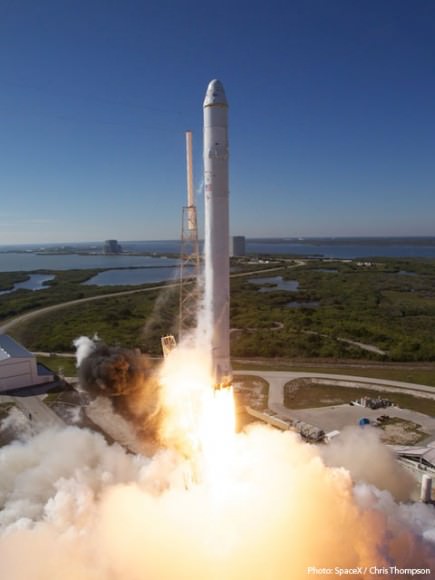
SpaceX said all nine Merlin engines performed “nominally,” which means they worked wonderfully. Together, the rocket engines generate one million pounds of thrust in vacuum, getting the entire stack off the ground and powering the first phase of flight. The rocket reached maximum dynamic pressure (the point at which aerodynamic stress on a spacecraft in atmospheric flight is maximized, also known as Max Q) approximately 1.5 minutes after launch. The first stage separation occurred a little over three minutes into flight.
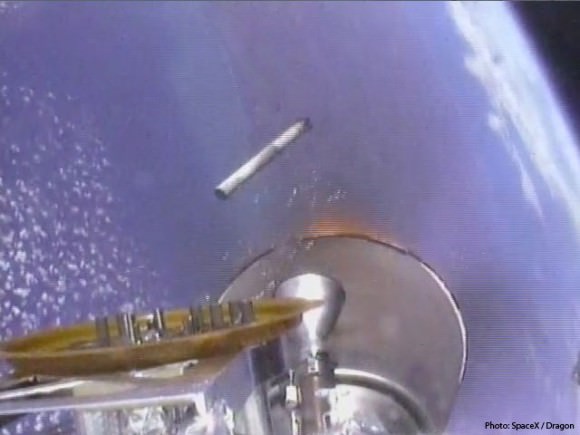
The single Merlin Vacuum engine of Falcon 9’s second stage then ignited to continue carrying the vehicle towards its targeted orbit. After stage separation, the nose cap at the front of the Dragon spacecraft safely jettisoned. The second stage fired for another four and a half minutes, until it achieved orbital velocity, and then the Dragon spacecraft separated from the second stage to begin its independent flight.
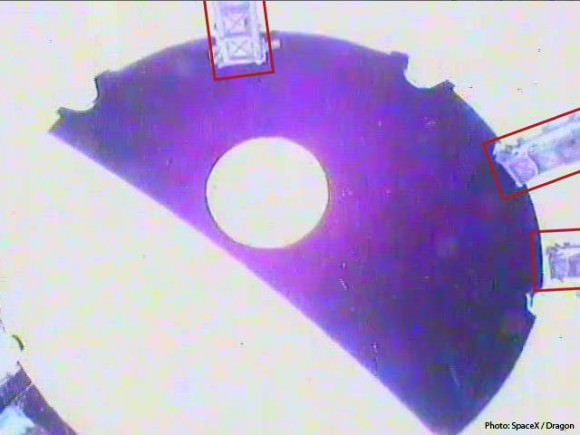
SpaceX said Dragon’s first-ever on-orbit performance was 100% successful in meeting test objectives including maintaining attitude, thermal control, and communication activities. While in orbit, eight free-flying payloads were successfully deployed, including a U.S. Army nanosatellite—the first Army-built satellite to fly in 50 years.
After separation of the Dragon spacecraft, the second stage Merlin engine restarted, carrying the second stage to an altitude of 11,000 km (6,800 mi). While restart of the second stage engine was not a requirement for this mission (or any future missions to the ISS), it is important for future Geosynchronous Transfer Orbit (GTO) missions, where SpaceX hopes to bring satellites for paying customers.
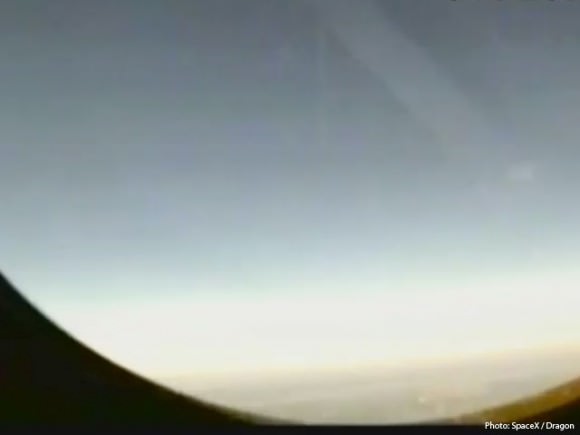
What’s the view like from inside Dragon? Here’s a view looking out Dragon’s porthole, with a view of Hawaii. After the second stage separated, there was an expected loss of signal as the Dragon spacecraft passed over the horizon as viewed from the launch site. At that point, SpaceX activated Dragon’s video signal from a camera set up inside the capsule, delivering the first ever video sent from Dragon on orbit.
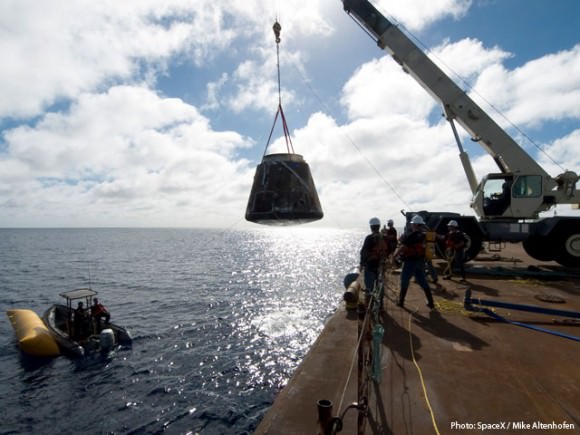
For this first flight under the Commercial Orbital Transportation Services (COTS) program, everything went perfectly, with a nominal flight profile that included a roughly 9.5-minute ascent, two Earth-orbits, reentry and splashdown. Falcon 9 delivered Dragon to orbit with an inclination of 34.53 degrees—a near bull’s-eye insertion, according to SpaceX.
Now, on to the next demonstration flight, which will go to the International Space Station, and maybe even dock, if SpaceX has anything to say about it.
See our previous gallery of images and videos from the launch.
Source: SpaceX
SpaceX Reveals Dragon’s “Secret” Payload
[/caption]
During Wednesday’s post-flight press conference, SpaceX CEO Elon Musk confirmed the rumor of a secret payload on board the Dragon spacecraft, but said he wouldn’t reveal what it actually was until Thursday. He did say, however that if you liked Monty Python, you would like this payload.
True to his word, SpaceX just issued a press release on what was inside this container, above, that was bolted to the floor of the Dragon spacecraft.
See below.
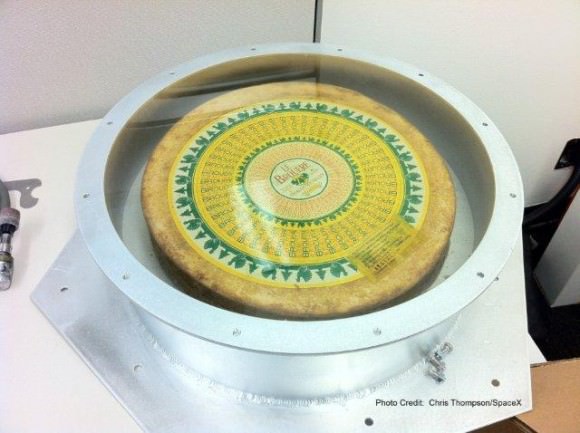
It was a wheel of cheese, which references a classic skit from Monty Python’s Flying Circus, where actor John Cleese tries to order cheese from a cheese shop that has no cheese.
A skit about cheese doesn’t sound funny, but it is. 42 different kinds of cheese are mentioned in the skit; the kind on board Dragon was Le Brouere cheese.
Many fellow journalists speculating on Twitter agreed that the secret payload was likely a can of Spam — which would reference both Monty Python’s hit “Spamalot” as well as pilot Chuck Yeager’s admonition that early astronauts were just like “Spam in a can.”
The SpaceX Business Plan: Help Build a Spacefaring Civilization
[/caption]
Elon Musk conceded that the space business world is an extraordinarily difficult place to make money. But that isn’t his main priority anyway.
“The reason I’m doing SpaceX,” Musk said during the Falcon 9/Dragon post-flight press conference, “is that I just happen to have a very strong passion for space and I want us to become true spacefaring civilization and even a multi-planetary civilization. That is my goal for SpaceX.”
“Other companies have profit goals and such, but for SpaceX it is really about furthering the cause of space,” Musk continued. “We must bring in more money that we spend, but maximizing profitability is not really what it is about.”
Musk said he has been upfront with investors in SpaceX that a high profit margin is not his priority, “and so they can’t be mad when that doesn’t happen.”
He added that he wants to make science fiction –“what you read about the future,” — to become reality.
The discussion of profit started when Musk revealed that the Falcon 9 second stage was restarted and flew to 11,000 km (6,800 miles) to release some secondary satellite payloads, including a U.S. Army nanosatellite. SpaceX was paid minimally for only some of those payloads, Musk said.
Wednesday’s test flight was the first of three financed by NASA under a $278 million Commercial Orbital Transportation Services (COTS) agreement, the main cog of a program designed to encourage commercial space companies to develop rockets and spacecraft to deliver cargo – and later perhaps crew — to the International Space Station after the space shuttle is retired next year.
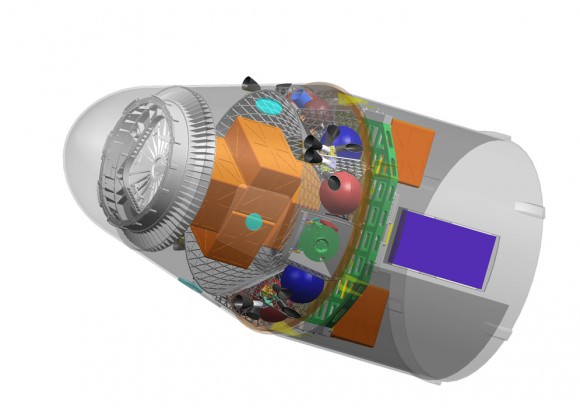
After the Dragon’s initial success, Musk said he hopes NASA will consider allowing Dragon to go directly to the International Space Station on the next flight, estimated to take place in mid-2011. Since Dragon is capable of carrying 5987 kg (13,200 pounds) of cargo in pressurized and unpressurized cargo bays, it can bring more than twice as much cargo as Russian Progress resupply ships.
Musk also thinks Dragon can compete with Lockheed’s Orion capsule, the only part of the Constellation Program that NASA has maintained.
“What I’m hopeful for is that NASA may consider the Dragon as good as Orion,” Musk said. “It is good to have multiple companies doing something, so Lockheed has Orion and we have Dragon and we would certainly like to have Dragon considered for anything that Orion could do. Perhaps we could do more because our heat shield is significantly more advanced.”
While Musk said SpaceX could not have gotten where it is today without NASA’s support and path-making, Alan Lindenmoyer, manager of NASA’s Commercial Crew and Cargo Program Office, said with the success of this flight, the benefits might be going both ways.
“As much as SpaceX is learning from NASA, there are certainly things we can learn from SpaceX,” he said.
Gallery: Dragon/Falcon 9 Launch and Recovery Photos, Videos
[/caption]
Enjoy a few glimpses at history from the Dec. 8 launch of Falcon 9 and Dragon.
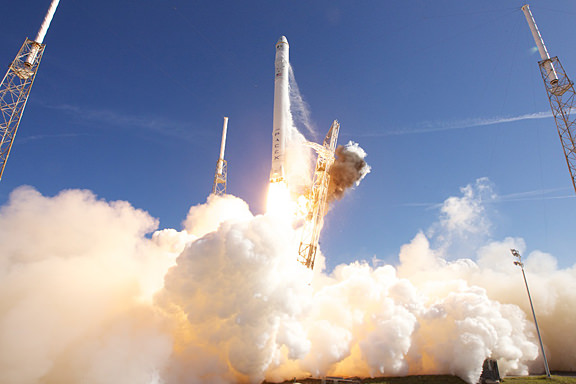
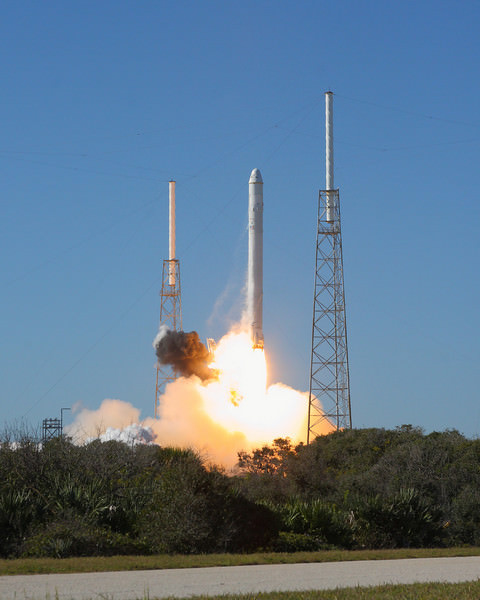
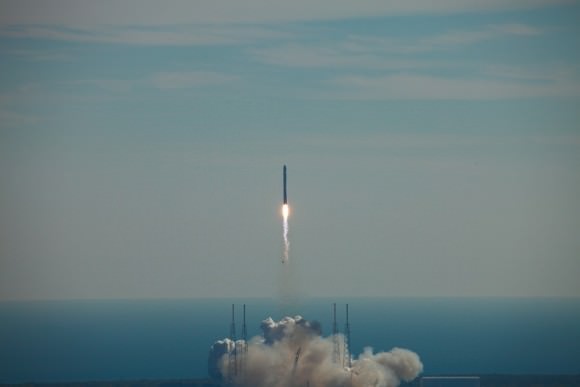
Here is video from a camera on Dragon while in orbit.
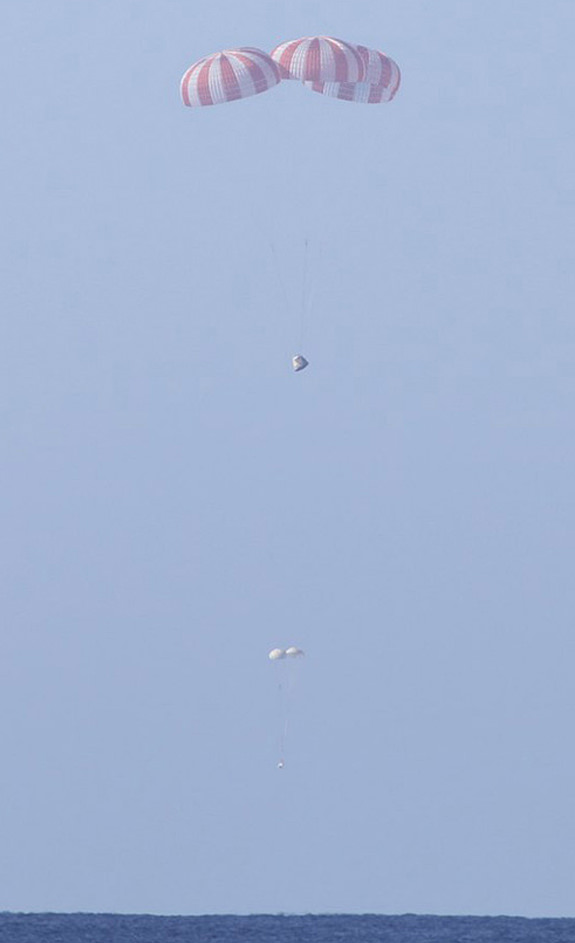
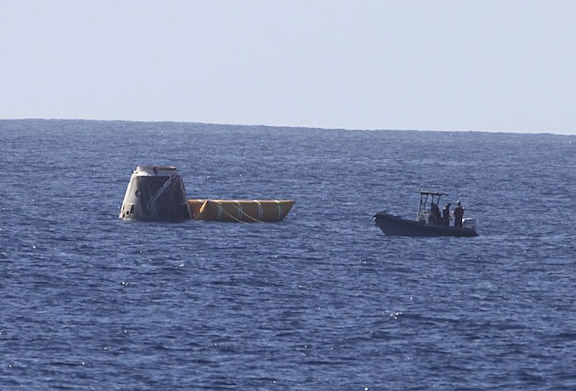
And for good measure, here’s the launch video again:
NASA Administrator Charlie Bolden’s statement on the success of the launch:
The Future is Now: SpaceX Flight 100% Successful

[/caption]
Hailed as a both a great day for commercial spaceflight as well as for NASA, SpaceX made history on Wednesday with a 100% successful test flight of its Dragon capsule and Falcon 9 rocket. “This is a new way of doing business,” said Alan Lindenmoyer manager of NASA’s Commercial Crew and Cargo Program Office, “and I would say today this is an indication that this public/private partnership is working and has proven to be successful. Thanks to SpaceX for the early Christmas present – this is a great way to start the holidays.”
At the press conference following the flight, SpaceX CEO Elon Musk at first appeared to be speechless: “Really, this has been better than I expected,” he said. “It all went right. I am sort of in semi shock—I wish I could be more articulate in moments like this, bit it’s hard to be articulate with a blown mind!”
But Musk soon found his words – and lots of them (with many great quotes, so keep reading…)

Lindenmoyer said SpaceX’s accomplishments are quite an achievement, since over the last 20 years, for new launch vehicles only about 50% of them are success are successful on their first or second flights, and only 1 out of 3 new vehicles have two successful flights in a row, which SpaceX has achieved.
Musk said the success really shouldn’t be a surprise since the Dragon spacecraft has so many redundancies: 18 thruster engines instead of 9, 3 parachutes when they really could land with one, extra thermal protection, and a very advanced heat shield. But in the end, SpaceX didn’t need to use any of the backup systems.
Preliminary data said the Dragon reentered the atmosphere spot on at a 12% angle of attack, with 2% dispersion. “This is a testament to the incredible work of the people at SpaceX,” he said. “Everyone did their jobs so well.”
Musk also emphasize that his company couldn’t have gotten to where they are without NASA, in not only monetary support ($278 million for the COTS program), but in leading the way in spaceflight.
“The core concepts of Falcon 9 and Dragon were demonstrated decades ago by NASA, and its an old saying, but we are only here because we stand on the shoulders of giants. So thank you,” he said.
Musk noted a few key things about the flight: The restart of Falcon 9’s second stage went perfectly; the second stage as restarted after the release of Dragon, and rose to an altitude of more than 11,000 km (6,800 miles), Musk said. Secondary satellite payloads of nanosatellites were released during the flight. And, Musk added, that altitude was with the trimmed, repaired nozzle. Reaching an altitude that high was not part of SpaceX’s primary objectives, but nice to have, Musk said.
Dragon went to an altitude of 300 km.
Musk also stressed that the difference between this Dragon capsule and one that could carry people isn’t that different.
“People sometimes think the different between cargo and crew required enormous amount of magical pixie dust,” he said “This is not the case. If there would have been people sitting in Dragon today, they would have had a nice ride, feeling about 4-5 G’s, which is about what an amusement park ride is like,” with an 8 meter per second descent speed which is quite comfortable from a landing perspective.

The only differences, Musk said, would be the addition of a launch escape system. And, he revealed, what SpaceX really hopes to do with future spacecraft is not a splashdown in the ocean but a propulsive landing on the ground.
“The architecture you saw today was similar to what was employed in Apollo era, but we are aiming for propulsive landing with gear, kind of like the Eagle landing on the moon, and being able to take off again” he said. “Full reusability of Dragon and Falcon 9 is important as well, and something we want to figure out over time.”
Musk also said this mission didn’t have many significant differences in one that would send the Dragon the ISS. “In our discussions with NASA they said if this flight went well they would strongly consider letting us go to the space station on next mission,” he said. “I hope that is what NASA will allow us to do, we need to still examine the data from this mission first, but I’m highly optimistic. There are additional elements to be added to Dragon such as solar panels and redundancy on flight computers and electronics, but feel highly confident we could make it to the ISS on our next flight by middle of next year.”
Today’s flight tested the fundamentals of a heat shield and precision landing. Musk said the performance of heat shield was spectacular, and projected that is could not only handle Earth reentry, but also lunar and Mars reentry.
SpaceX president Gwynne Shotwell noted some other technical details, of how Dragon was able to maintain attitude and thermal control, as well as maintain communications with ground stations and TEDRIS satellites, which requires specific directional pointing.
The entire launch and two orbit flight took 3 hours 19 min 52 seconds, and initial data said they landed within 10 km of their target, and a communiqué from the Air force said Dragon came within 800 meters.
Asked about the flame flare that came about 2 seconds after launch, Musk said the first look by engineers said it was a check valve on the second stage umbilical that came off and caught fire as the spacecraft engines passed by — not an explosion but a just little fire.
Musk said the point in the flight where he felt the most jubilation and great relief was when the parachutes deployed. “Drogue and main chute deploy were riskiest parts, so when that happened, it was done deal. Just mind-blowingly awesome.”
Asked if the success today would silence any of SpaceX’s critics, Musk said, “I think if there really are people who are going still find a way to cast aversions on what we’ve done today, I pity them. It just wouldn’t make any sense.”
He said politicians who initially wanted to cut commercial crew funds from NASA’s budget soon learned that such a move would not decrease but increase the deficit and also meant increased time with no American access to space. “I think some politicians were initially mislead, but then they realized the value of commercial crew, which is why it the cuts didn’t make it into the final report.”
Asked about the differences in Dragon and NASA’s Orion spacecraft, Musk said that Space X would probably be the most rapid path to an American crew transport system. “If we would have had people on this flight we would have taken them to orbit and returned them safely,” he said. “Going to a crew system is just adding some additional safety systems for highly off nominal activities. Even for cargo missions we will be carrying plants and animals so I think we are in a very strong position to be one of the winners of the commercial crew contract.”
Musk added that competition is good, however, and NASA shouldn’t be too dependent on one company,” so hopefully there will be two or maybe three commercial crew providers and hopefully we are one of them.”
Musk agreed with Lindenmoyer on how this appears to vindicate the public/private model of space flight and shows that the commercial model works just as well in space flight as in air flight, or other arenas.
“The air mail program was a huge boost when the Post Office went commercial,” he said “and that resulted in explosion of innovation and improvement in technology. It really was the dawn of aviation in American where it went from joy rides that rich people could do, to today where aviation is accessible to almost everyone. I think historically COTS program will be seen in that light.”
On board Dragon was a few small satellites, and look for Musk to reveal tomorrow the nature of a humorous item that was on board. “I’m not going to reveal it today, as I don’t want some of the editors to use it in the first headlines,” he said. “It is kind of funny and if you like Monty Python you’ll like this one.”
Spam in a can?
Universe Today extends their congratulations to SpaceX. The future appears to be now.
SpaceX Delays Falcon 9 Launch Attempt To Dec. 9
[/caption]
SpaceX will delay the launch attempt of the Falcon 9 rocket until at least Thursday, Dec. 9. At a press conference today, company president Gwynne Shotwell said a final review of closeout photos this morning found some indications of a potential issue on a second stage nozzle. Reports from journalist Robert Pearlman on Twitter said the Falcon 9 had been lowered from the vertical launch position. And Shotwell said if they have to replace the nozzle, the launch would be no earlier than Friday, Dec. 10.
“During an inspection of final closeout photos they determined there were some indications in a weld joint that they wanted to take some additional steps to look at,” said Shotwell, “and they brought the vehicle down to horizontal. I believe it is back up to vertical now.” When asked for details, Shotwell said “porosity and potential cracking in a weld joint.”
There were some weather concerns for the early to mid part of this week, but the weather improves later in the week, so perhaps the delay was going to happen anyway.
This is the first demonstration launch for NASA’s Commercial Orbital Transportation Services (COTS) program, with a functional Dragon capsule.
SpaceX CEO Elon Musk has said he thinks they have a 70% chance of successful first flight of the Falcon 9/Dragon capsule.
Shotwell agreed, saying history predicts SpaceX will likely have a substantial issue to deal with in this test flight.
“Given we got Falcon 9 to orbit on our first test flight, I’d say 70% for this flight, too,” she said.
At the press conference, NASA’s Phil McAlister, from the Office of Program Analysis and Evaluation, provided some insight into NASA’s thinking on if there were to be substantial problems with any of the COTS test flights. “We expect anomalies and the purpose of a test flight is to find the problems,” he said. “We won’t know until the end of the program if we’ve been completely successful, but to date this has been remarkably successful. Even if we have a bad day on this flight, for example, we expect to move forward. It is not a condition that every test flights be successful. We are committed to learn from each flight. But we would certainly like to have a a successful flight. So far we are on very good track and we will learn a lot from this test flight and move forward regardless of the outcome.”
The key milestones for this flight are a successful launch, separation of the Dragon vehicle from the rocket and successful reentry of Dragon.
No matter the outcome of this flight, SpaceX plans on having next Dragon flight ready by late spring/early summer 2011.
For the future, McAlister also said that he believe competition is very important, and that NASA would like to have at least 2 cargo service companies. “We would like to have routine, cost effective cargo services to LEO by 2020.”
Shotwell said it would be at least two and a half to three years after the cargo program is initiated is the first chance for astronauts to be ferried on board the Dragon capsule.
SpaceX Test Fire Aborted
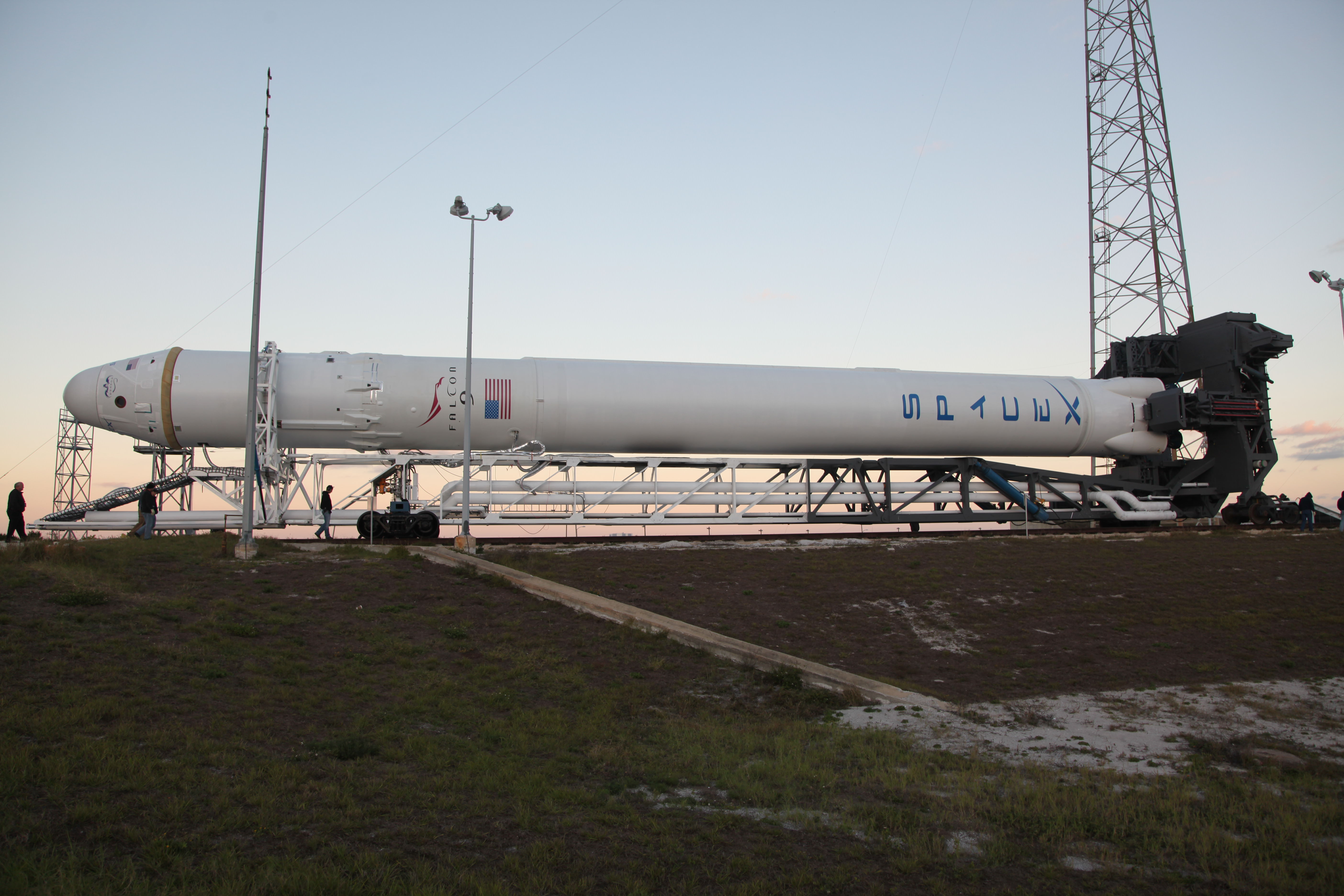
A static test firing of the SpaceX Falcon 9 rocket was cut short as computer systems shut down the first-stage engines before the test was complete. The firing was only going to last two seconds, but the engines ran for 1.1 sec due to high engine chamber pressure, according to SpaceX. Space News reported that engineers are analyzing the data and that a second attempt is likely to occur tomorrow, Dec. 4. This abort occurred just four days before SpaceX is schedule to conduct the maiden launch of its Dragon space capsule on board the medium-class Falcon 9.
This video is from SpaceX’s webcast of the firing and unfortunately is a bit jumpy.
The first-stage firing was part of a dress rehearsal conducted in preparation for the planned Dec. 7 launch, the first of three increasingly complicated flight demonstrations of Falcon 9 and Dragon under the company’s Commercial Orbital Transportation Services (COTS) agreement with NASA.
[/caption]
In a press release from SpaceX from Dec. 2, the company said the rehearsal would “exercise the countdown processes and end after the engines fire at full power for two seconds, with only the hold-down system restraining the rocket from flight.”
After the test, SpaceX said they would conduct a thorough review of all data as engineers make final preparations for the upcoming launch.
The rockets uses kerosene and liquid oxygen, and the nine Merlin engines generate one million pounds of thrust in vacuum.
The $278 million COTS agreement has SpaceX developing and demonstrating hardware capable of ferrying cargo to and from the International Space Station.
We’ll post more information about the abort as it becomes available.
Dragon Drop Tests and Heat1X-Tycho Brahe Set to Launch – SpacePod 2010.08.24
Home made rockets launched from home made submarines next to dragon wings floating in the ocean on your SpacePod for August 24th, 2010
Before we begin I just wanted to give a shout out to our new viewers on both Space.com and Universe Today. Hopefully you like what you’ll see and you’ll stick around for a while, check out some of our other videos and join us for our live weekly show all about space. For today though, lets start over the Pacific Ocean where SpaceX tested the Dragon’s parachute deployment system on August 12th, 2010.
Continue reading “Dragon Drop Tests and Heat1X-Tycho Brahe Set to Launch – SpacePod 2010.08.24”
Interview with Elon Musk
SpaceX founder, CEO and CTO Elon Musk sat down with the Spacevidcast team for about 20 minutes to talk about space and SpaceX. This is the 10 minute SpacePod edition which has a little under 1/2 the interview available. We chat about the Falcon X, the future of space and why he built SpaceX.

